What Makes a School an Ivy League school?
There are eight private colleges that make up the ‘Ivy League,’ and specifically the Ivy League Athletic Conference. These northeastern schools are; Columbia University, Harvard University, University of Pennsylvania, Cornell University, Dartmouth College, Yale University, Princeton University, and Brown University.
The term ‘Ivy League’ was first used in 1937 by a New York Tribune journalist in reference to college football.
The “Ivy Group Agreement” was formally signed by the management of these eight colleges in 1945 to establish common tenets for maintaining high academic standards, define eligibility standards and extend financial aid to sportsmen. Initially, the focus was on football but with time it extended to other sports.
The “Ivy League” came into existence in February of 1954, when the Ivy Group Agreement was upgraded to include all sports and promote high-level of inter-collegiate competition while continuing to maintain high academic standard. What started off initially as a reference to sporting standard, has over the years evolved into becoming a gold standard in academic and overall excellence.
Today, the Ivy League has established itself as a diverse inter-collegiate sporting championship in the United States with over 8,000 student-athletes actively competing annually in various sports.
Since inception of inter-collegiate competition, Ivy League teams have won 287 team national championships and 579 individual national championships.
There is a common misconception that the Ivy League includes institutions like MIT and Stanford but they are not part of the Ivy League.
Questions are often raised whether the Ivy league will be expanded to include other colleges but as of now, the exclusive ‘eight’ have maintained their brand premium by remaining a tightly knit and much-sought after club.
The pride of studying in an Ivy League college is extended across the student community and alumni network that have supported and maintained the exclusivity through attaining excellence in all fields covering liberal arts, humanities, STEM subjects, sport, and performing arts.
Related Maps:









